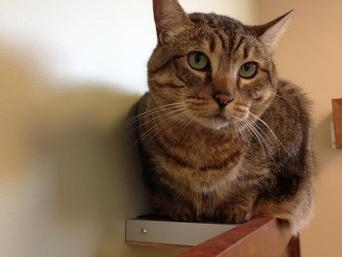 Ignore my muffin tops please Happy New Year Everyone!
I’m Miss Shirley and I am a chubby kitty. This is the story of my search for my thin kitty within. I am hoping to find my permanent home and my forever diet buddy, too.
Once upon a time, I was a normal-sized kitty. I’m not a piggy. Sometimes I leave a little food in my bowl. But I do like to lounge. I guess that was my downfall—no exercise.
When my family surrendered me to the shelter they were warned that some kitties don’t qualify for re-homing. I guess we were in denial of what could happen to me. The shelter staff told me I was too fat for their adoption program—even though I was a very friendly girl. If I didn’t find a rescue group, I would be “put to sleep.” I knew what that meant. Gulp!
So I talked to every worker and every volunteer. I greeted them with a chirp and nuzzled against the cage seductively. “Rub my head. Scratch my ears.” I have a very deep and gravelly voice and I tried to sound as sweet as I could. Some people say I sound like Lauren Bacall or Demi Moore. I say, “Who are they?”
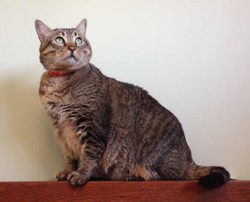 I'm just big boned My strategy worked! The St. Francis Rescue people took me to a foster home that San Jose Animal Advocates found. They arranged for my enrollment at Club Chub! Pinnacle Animal Hospital in San Jose has specialists in weight reduction and I met my doctor. Doctor Forgy was going to help me get thin so I could find a forever home! I learned that she donated her services to me because I was a rescue girl. I thought it was because of all the talking I did when we met.
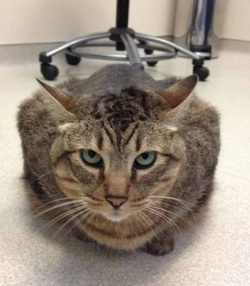 Going on a diet sucks! First, she checked my blood work. All my enzymes and electrolytes were good. Even more important—my glucose level was good. I’m not diabetic or pre-diabetic! Hooray! That improves my chances of weight loss success AND it improves the chance that I will find my forever home.
Next, she weighed me. I weighed 15.5 pounds. On my frame, that’s fat. I’m about 30% overweight and that’s morbidly obese. She took photos. No hiding the truth anymore.
Then, I was given my diet. Hill’s metabolic diet. M/D. Only ¼ cup, two times per day. The local distributor for Hill’s knew I was a rescue kitty and donated my food!
That was last November. Check back here to read more of my story.
This blog post has been contributed by Karen Zamel, SJAA Volunteer 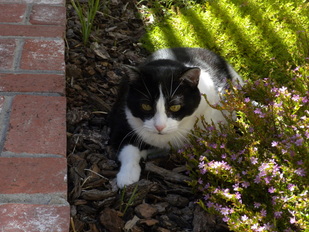 Karen's 15 year old "Mopps" As cats age, their health and wellness needs change – just like with adults. We have four cats at home, and three of them are “geriatric” – ages 13, 14 and 15. As with most pet owners, we want to keep them healthy and happy as long as possible. Our vet, Dr. Jane Johnson of Adobe Animal Hospital in Los Altos, has helped us learn about and address issues that occur for our aging family felines, and has been generous enough to share some of her important insights here.
Dr. Johnson has been part of the Adobe team since 1985 – first as a tech, and then as a vet. She has a degree in chemistry from Princeton, and a degree in Veterinary Medicine from UC Davis.
Many thanks to Dr. Johnson for these answers to our questions...
 15 year old Bosco 1. At what age are cats considered "senior"?
Cats, especially indoor cats, can live over 20 years. They are considered "senior" starting at about 13 or 14 years old.
2. As pet owners, what should we watch for as our cats age?
The main things to watch for are changes – in appetite, drinking, weight, activity level, appearance, elimination habits, breathing – or the appearance of any symptoms such as coughing, sneezing, vomiting, diarrhea.
3. Are there differences in well care as our cats become older – for example, the frequency or type of vet visits?
In the older cat, we usually recommend coming in every 6 months instead of yearly, and we often will do blood tests, radiographs or other diagnostic procedures, especially if any of the above symptoms are present.
4. Dental issues are always a concern in senior cats...what kind of tooth and gum care do senior cats need?
Dental care should start at a young age, ideally with brushing the cat's teeth at least a few times weekly. In any case, the teeth and gums should be evaluated at each veterinary visit, and they should definitely be checked if you notice redness, bleeding, bad breath or masses in the mouth. Often times, the teeth need to be cleaned to eliminate plaque and the bacteria that can cause problems in the entire body. We do not recommend the anesthesia-free teeth cleaning, as these procedures do not address any decay or infection that may be occurring under the gums, and they can often lead to broken teeth and retained, infected roots.
5. What should we be alert about as our cats age? Are there changes that are okay, vs. changes we should be concerned about?
As in #2 above, most of the changes that you see in your older cat should at least be evaluated to make sure that they are part of natural aging, rather than part of a disease process. In older cats, probably the number one indication for seeing your vet would be the cat starting to drink more water – as cats age, they are prone to developing kidney disease, hyperthyroidism, or diabetes, and drinking extra water can be the first symptom of these problems.
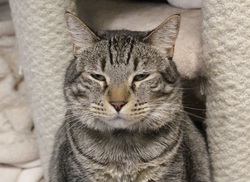 Hamilton is available at the San Jose shelter Consider Adopting a Senior…Shelters are looking urgently to find temporary or permanent homes for mature and senior cats. These loving animals are often overlooked for kittens – even when they are perfect for the adoptee. Adopting a mature or senior cat from the local shelter can be a heart- and home-warming experience. These cats can provide amazing companionship, friendship, and love. A perfect example of a wonderful senior kitty is Hamilton who is 8 years young. He has been waiting patiently at the San Jose Animal Care Center while many kittens have been adopted. This confident love muffin is waiting for you to come and adopt him. Seniors rule!
This is the first of a series of kitten related blog posts contributed by Tonya Jensen, SVACA Kitten Foster Mom volunteer, and new SJAA volunteer.
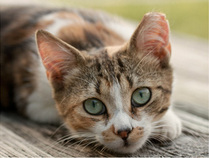
Homeless feral cats are a sad fact of our community. Numerous kittens that are not old enough or suitable for adoption are euthanized each year as a result of unmanaged feral colonies. In recent years Trap/Neuter/Return (TNR) programs established in various locations throughout the San Francisco Bay Area are becoming an important part of the solution.
What Is the Difference Between a Stray Cat and a Feral Cat? According to the ASPCA, “a feral cat is primarily wild-raised or has adapted to feral life, while we [the ASPCA] define a stray cat as someone's pet who has become lost or has been abandoned. Stray cats are usually tame and comfortable around people. They will frequently rub against legs and exhibit behaviors such as purring and meowing. In contrast, feral cats are notably quiet and keep their distance. Stray cats will also often try to make a home near humans—in car garages, front porches or backyards. Most are completely reliant on humans as a food source and are not yet able to cope with life on the streets.” What is TNR?
Trap/Neuter/Return (TNR) is a humane way of trapping of domestic cats that live in the community without formal homes and survive by gathering food and shelter where they can. The trapped cats are spayed/neutered, vaccinated, sometimes treated for other medical issues, and micro chipped. Their ears are notched so that they may be identified as spayed/neutered. They are returned to a colony in the community. What is the benefit of TNR?
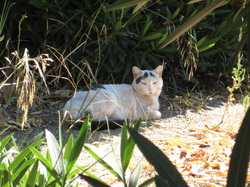 The ASPCA writes, “TNR helps the community by stabilizing the population of the feral colony and, over time, reducing it. At the same time, nuisance behaviors such as spraying, excessive noisemaking and fighting are largely eliminated, and no more kittens are born. Yet, the benefit of natural rodent control is continued. Jesse Oldham, ASPCA Senior Administrative Director of Community Outreach and the founder of Slope Street Cats, an organization dedicated to feral cat welfare, notes, “TNR also helps the community's animal welfare resources by reducing the number of kittens that would end up in their shelters—TNR creates more space for the cats and kittens who come to them from other avenues.”
According to The Cat Resource Center, a Santa-Clara based cat rescue organization, additional benefits of TNR include: “Sterilizing cats saves tax dollars, vaccination prevents disease, and TNR is the most effective and humane option for feral cats.”
Who Provides and Pays for TNR? TNR begins with various rescue groups, individuals, and in some cases, compassionate businesses. Often these dedicated people trap and provide veterinary care and food for the colonies (often paying for the procedures themselves). At times they partner with local shelters or veterinary hospitals that volunteer veterinary procedures. Available funds (from limited budgets, grants and donations) determine how many procedures a shelter can contribute to TNR. The Fate of Feral or Surrendered Kittens 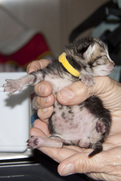 Policies vary among organizations and shelters regarding the fate of surrendered kittens. Kittens must weigh two pounds before they can be spayed/neutered, yet this procedure is required by law before kittens can be adopted from a rescue group or shelter. The availability of foster families will play a key role in the number of neo-nate kittens a shelter or organization can accept for adoption. Without foster families it is impossible for organizations and shelters to provide the care these tiny babies require, thus some precious lives may not have a chance. Before surrendering neo-nate kittens, check with organizations and shelters regarding their policies.
Feral Cat Resources:
 UPDATE: Bosco was rescued and is living a wonderful life in San Francisco! Here is a recent photo of him taken by his talented mom. We wish you well Bosco - you deserve it!
I have always respected Muttville Senior Dog Rescue. These special folks, led by Sherri Franklin, save senior dogs from shelters all over the Bay Area. They know how special these senior dogs are, and how they make the perfect companion for many folks who are looking for a more mellow friend. Unfortunately, we don't have a local cat rescue group which focuses on senior cats. Senior cats present a particularly difficult problem especially during kitten season when adult cats are overlooked for kittens at our shelters. Ironically, cats typically live longer lives than dogs, yet few people want to give a senior cat a chance. Like senior dogs, senior cats provide gentle, low key companionship. Their active days are behind them, but they are wiser, and have so much love to give.
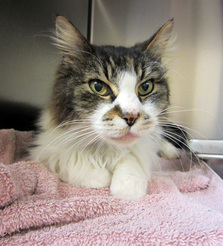
Meet Bosco. The shelter thinks this guy is about 15 years old, but he certainly doesn't look it. Bosco was turned in to the shelter after being found roaming the neighborhood. He had been someone's cat, but they had left the neighborhood and didn't bother taking him with them so Bosco had to fend for himself.
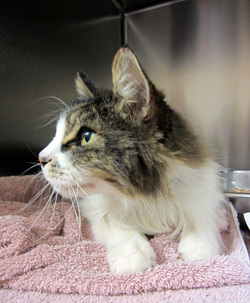 When I met Bosco yesterday at the shelter, he was calm and grateful to be petted. He immediately starting to make biscuits with his massive paws, and strangely seemed relieved to be in the shelter. Unfortunately, what he doesn't know is that he has very little time to stay there before he will be euthanized if he doesn't get rescued. The good news is that we do have a rescue group who is willing to pull this sweet old man, but we need a foster home or a permanent home for him.Did you know that cats can live into their 20s? By the looks of Bosco, he has a lot of living left. His one wish? A home that commits to him for life and won't leave without him again. He's ready for his new chapter, can you help him find his special person?Contact us if you can help Bosco!
|








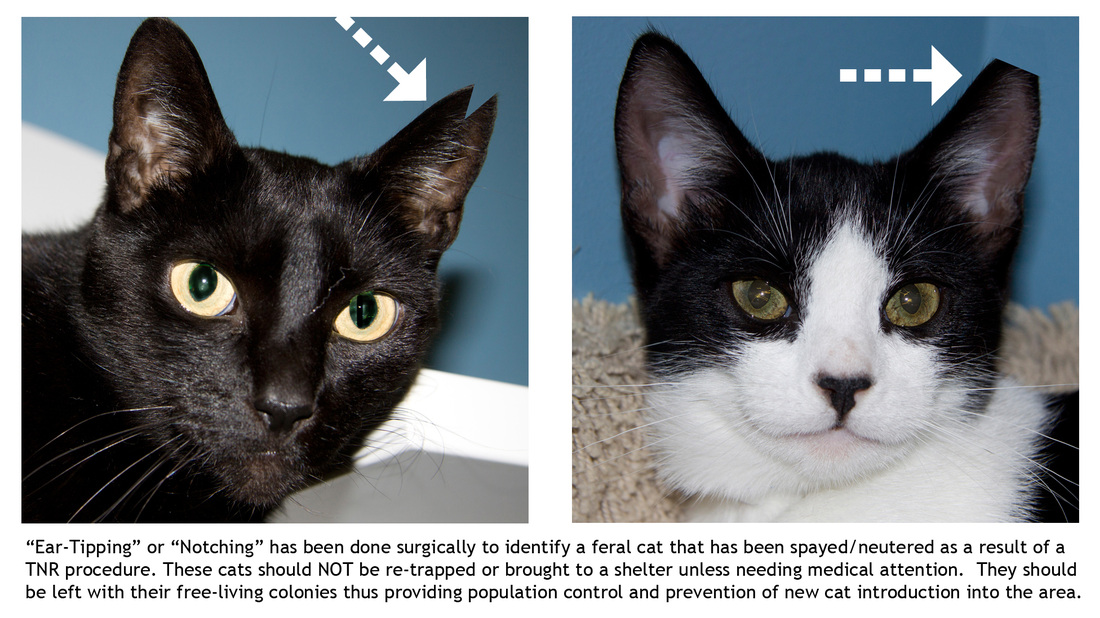





 RSS Feed
RSS Feed